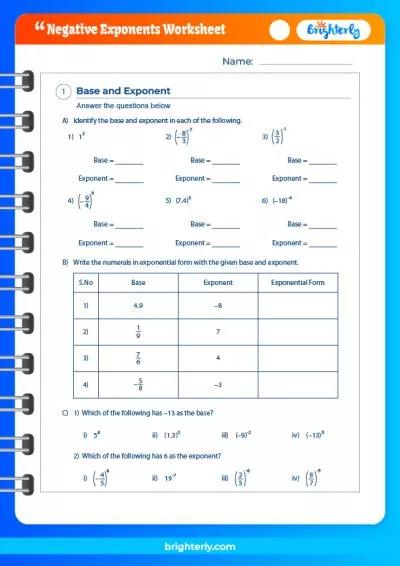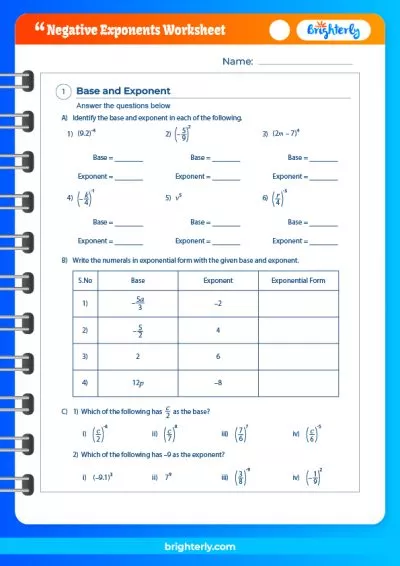Negative Exponents – Rules, Definition With Examples
Updated on January 9, 2024
Welcome to another engaging article from Brighterly, your trusty guide to all things mathematical! Today, we’ll be venturing into the world of negative exponents. Exponents, those little numbers perched high above their larger counterparts, can be quite a mystery for young learners. When they turn negative, the sense of intrigue only deepens. But fret not, as we’re about to demystify these numerical quirks and turn them into a powerful tool in your child’s mathematical arsenal.
In essence, an exponent refers to the number of times a number (or base) is multiplied by itself. A negative exponent, though, performs a little mathematical magic, transforming the base number into its reciprocal. This process might seem complicated, but we assure you, it’s like learning a new dance step. Once you’ve got the hang of it, it will become second nature. So, get ready to join us on this fascinating journey into the realm of negative exponents.
What Are Negative Exponents?
Before we delve into the nuances of negative exponents, it’s critical to first understand the core concept of exponents. By definition, an exponent refers to the number of times a number (or base) is multiplied by itself. For example, 2^3 implies that 2 is multiplied by itself thrice, resulting in the value 8.
In contrast, a negative exponent flips the base number into its reciprocal. The law of exponents states that for any nonzero number a, a to the power of -n (or a^-n) is equal to 1 divided by a^n (or 1/a^n). So, if we have 2^-3, it converts to 1/2^3 or 1/8.
Thus, a negative exponent is not about producing a negative result; instead, it alters the position of the base number in a fraction. It’s a little bit like stepping into a mathematical mirror universe!
Definition of Negative Exponents
In mathematical terms, for any nonzero number a and any positive integer n, the expression a^-n is defined as 1/a^n. This means that the negative exponent turns the base into its reciprocal and the exponent into a positive value. It’s like doing a backflip in the world of mathematics – you’re still dealing with the same components, but they’re in entirely new positions.
For instance, consider the number 5^-2. According to the definition, we switch the 5 (our base) to its reciprocal (1/5) and the -2 (our exponent) to its positive form (2). This gives us (1/5)^2, which equals 1/25.
Definition of Positive Exponents for Contrast
On the other hand, positive exponents function more intuitively. The expression a^n means that the base a is multiplied by itself n times. If n is a positive integer, then a^n equals a × a × … (n times).
For example, with 2^3, we multiply 2 by itself three times (2 × 2 × 2), yielding a result of 8. In this case, the base remains the same, and the exponent indicates the number of times the base is multiplied.
Positive exponents maintain the base number and its position, demonstrating straightforward multiplication, while negative exponents offer a unique twist.
Properties of Negative Exponents
Negative exponents exhibit fascinating properties that help simplify complex equations. Here are some key features:
-
Multiplication:
a^-m * a^-n = a^- (m+n). When bases are the same and multiplied, add the exponents. -
Division:
a^-m / a^-n = a^- (m-n). When bases are the same and divided, subtract the exponents. -
Power of a Power:
(a^-m)^n = a^-mn. When a power is raised to another power, multiply the exponents. -
Zero Exponent:
a^0 = 1. Regardless of the base (except 0), any number to the power of zero is 1.
Properties of Positive Exponents for Contrast
Positive exponents, like their negative counterparts, have properties that allow us to manipulate and simplify expressions:
-
Multiplication:
a^m * a^n = a^(m+n). When multiplying like bases, add the exponents. -
Division:
a^m / a^n = a^(m-n). When dividing like bases, subtract the exponents. -
Power of a Power:
(a^m)^n = a^(mn). When raising a power to another power, multiply the exponents. -
Zero Exponent:
a^0 = 1. Regardless of the base (except 0), any number raised to the power of zero is 1.
Difference Between Negative and Positive Exponents
The main difference between negative and positive exponents lies in how they manipulate the base number. While positive exponents keep the base number intact, multiplying it by itself the given number of times, negative exponents flip the base number into its reciprocal.
Positive exponents represent straightforward multiplication, while negative exponents provide a shortcut to dealing with fractions and reciprocals. It’s as if each operates in its own mathematical realm.
At Brighterly, we believe that practice is the key to mastery. That’s why we invite you to explore our negative exponents worksheets, where you can find an array of additional practice questions, complete with answers.
Rules for Working with Negative Exponents
Working with negative exponents is relatively straightforward once you understand the rules:
- Turn the base into its reciprocal.
- Convert the negative exponent into a positive one.
- Perform multiplication or division as required.
Remember, a negative exponent doesn’t make the result negative. Instead, it affects the position of the base in a fraction.
Writing Expressions with Negative Exponents
Here’s how you might write expressions using negative exponents:
a^-nbecomes 1/a^n(ab)^-nturns into 1/(ab^n)a^-n * b^-mchanges to 1/a^n * b^morb^m / a^n
Simplifying Expressions with Negative Exponents
Simplifying expressions with negative exponents typically involves flipping the base and exponent to their reciprocals and positive counterparts, respectively. For example, 3^-2 simplifies to 1/3^2 or 1/9. Expressions like a^-n * b^-m simplify to b^m / a^n.
Practice Problems on Negative Exponents
- Simplify 4^-3.
- Simplify
(3^-2)^2. - Simplify
2^-3 * 3^-2.
Try these problems out to test your understanding of negative exponents!
Conclusion
Bravo! You’ve just delved into the intriguing world of negative exponents with Brighterly. These interesting elements of mathematics might have seemed daunting at first, but now you can see they’re simply a way to express reciprocals or fractions, opening a whole new realm of simplification.
As your young learner continues to explore and understand these concepts, they’ll be unlocking doors to more complex mathematical concepts, building confidence along the way. Just remember, the key to mastery lies in persistent practice, patience, and a solid grasp of the basics.
Keep encouraging your child to test their understanding with various problems and exercises. After all, math is a language best learned through practice and application. And as always, Brighterly is here to light the way, turning complexity into curiosity, and helping your child shine brighter every day!
Frequently Asked Questions on Negative Exponents
What is a negative exponent?
A negative exponent takes a unique approach to mathematical calculations. It’s a way of writing fractions or reciprocals using exponents. Instead of having a number divided by a base raised to a power (e.g., 1/2^3), you can express the same idea with a negative exponent (e.g., 2^-3). It’s like a secret code in math, making complex fractions easier to handle.
Does a negative exponent make the result negative?
No, it’s a common misconception that negative exponents result in negative numbers. Instead, negative exponents affect the position of the base number, flipping it into its reciprocal. The number remains positive unless the base number was negative initially. So, in a nutshell, negative exponents deal more with fractions and reciprocals than they do with negative numbers.
How do I simplify expressions with negative exponents?
Simplifying expressions with negative exponents is like solving a fun puzzle. The first step is to flip the base into its reciprocal, changing the base’s position in a fraction. The next step is to convert the negative exponent into a positive one. After these two steps, you can proceed to multiply or divide as the problem requires. With practice, your child will become proficient at handling negative exponents, simplifying mathematical expressions with greater ease and understanding.






